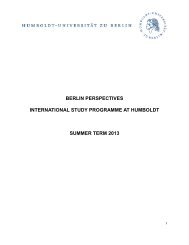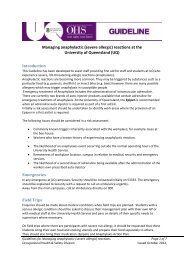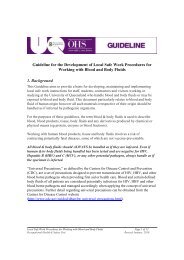Managing Traffic Incidents - University of Queensland
Managing Traffic Incidents - University of Queensland
Managing Traffic Incidents - University of Queensland
You also want an ePaper? Increase the reach of your titles
YUMPU automatically turns print PDFs into web optimized ePapers that Google loves.
Roads and <strong>Traffic</strong> Authority <strong>of</strong> NSW<br />
<strong>Managing</strong> <strong>Traffic</strong> <strong>Incidents</strong><br />
Current integration <strong>of</strong> traffic management<br />
activities is fragmented. Communication is<br />
predominately by telephone, e-mail and fax.<br />
Closed circuit television coverage is transmitted<br />
between the Main Roads <strong>Traffic</strong> Management<br />
Centre, the Brisbane City <strong>Traffic</strong> Control<br />
Centre and Police Communications.<br />
A trail joint initiative by Main Roads-<br />
<strong>Queensland</strong> Police Service called Operation<br />
Freeflow was undertaken in the three months<br />
ending June 2001. The trial included motorcycle<br />
police performing mobile patrols on selected<br />
motorways within Brisbane during the<br />
morning and evening peak periods to significantly<br />
reduce the response time<br />
<strong>Traffic</strong> Control Centres<br />
Sydney’s Transport Management Centre<br />
(TMC) was commissioned in August 1999 in<br />
readiness for the Sydney 2000 Olympic<br />
Games. The Roads and <strong>Traffic</strong> Authority<br />
(RTA) purpose-built the new TMC at a cost <strong>of</strong><br />
$A30 million. During the Olympic Games it<br />
was the command and control centre for<br />
Olympic public transport and traffic.<br />
RTA, Police and State Transit Authority<br />
(public transport) <strong>of</strong>ficers operate the control<br />
centre and pr<strong>of</strong>essional and support staff are<br />
co-located to maximise support capabilities.<br />
The Victorian State government traffic authority,<br />
VicRoads, operates a <strong>Traffic</strong> Control<br />
and Communication Centre which manages<br />
the 3,400 traffic signals across the state and<br />
over 140 CCTVs in Melbourne (other than on<br />
the City Link Tollway) and handles 250,000<br />
telephone calls each year, <strong>of</strong> which over<br />
60,000 are requests for assistance. VicRoads’<br />
automatic incident detection system, utilising<br />
loop detectors on the major freeways, is also<br />
being used in Adelaide.<br />
MRWA has recently established a new traffic<br />
control centre,<br />
which includes a<br />
system installed by<br />
MI Transport Systems<br />
similar to the<br />
CCCS being used by<br />
City Link in Melbourne.<br />
A digital<br />
camera based automatic<br />
incident detection<br />
system is also<br />
currently being<br />
evaluated.<br />
Incident Management Systems<br />
<strong>Queensland</strong> Main Roads has a manual incident<br />
management system, relying mainly on<br />
telephone calls from the public, which are<br />
verified through cameras, but also has a semiautomatic<br />
incident detection capability using<br />
in-road loop detectors.<br />
Incident management modules are being<br />
included in the redevelopment <strong>of</strong> Main Roads<br />
traffic management system (STREAMS), including<br />
automatic incident detection based on<br />
a combination <strong>of</strong> loop and video detection<br />
systems and sophisticated analysis and prediction<br />
algorithms. Systems will be available for<br />
incident logging, reporting and analysis and<br />
preset response plans. Future plans include<br />
extending incident management systems from<br />
freeways to heavy trafficked local streets and<br />
producing automated incident response plans<br />
for decision support.<br />
RTA NSW has been putting considerable<br />
effort is being focussed on progressively developing<br />
preset automated incident response<br />
plans (25 staff are currently involved in response<br />
planning and system configuration).<br />
Responses include providing a detour, changing<br />
traffic signal timing through SCATS,<br />
changing speed limits through variable speed<br />
signs and advisory messages to motorists over<br />
a network <strong>of</strong> variable message signs.<br />
The incident management system consists<br />
<strong>of</strong> a Central Management Computer System<br />
(CMCS) which is either activated through the<br />
automated incident detection system or by the<br />
operator. The CMCS supplied by Serco Systems<br />
is based on the NADICS system in Scotland.<br />
The Melbourne City Link comprising 22 km<br />
<strong>of</strong> upgraded and new freeways, transforms the<br />
existing freeway system, dramatically reducing<br />
traffic congestion. It is the world's largest<br />
application <strong>of</strong> electronic tolling technology at<br />
freeway speeds in an urban road setting, making<br />
the tollway one <strong>of</strong> the first to commit fully<br />
to the concept <strong>of</strong> cashless tolling. The focus<br />
on incident management is to ensure a high<br />
level <strong>of</strong> service to toll road users.<br />
It is a single operator controlled tollway using<br />
a Central Control Computer System<br />
(CCCS). The CCCS solution integrates traffic<br />
management and tunnel plant control systems<br />
into a single operator interface and includes a<br />
state-<strong>of</strong>-the-art incident management system,<br />
with automatic incident detection by real time<br />
2 DECEMBER 2001





![Recycling [ PDF, 62KB ] - University of Queensland](https://img.yumpu.com/51805185/1/184x260/recycling-pdf-62kb-university-of-queensland.jpg?quality=85)











